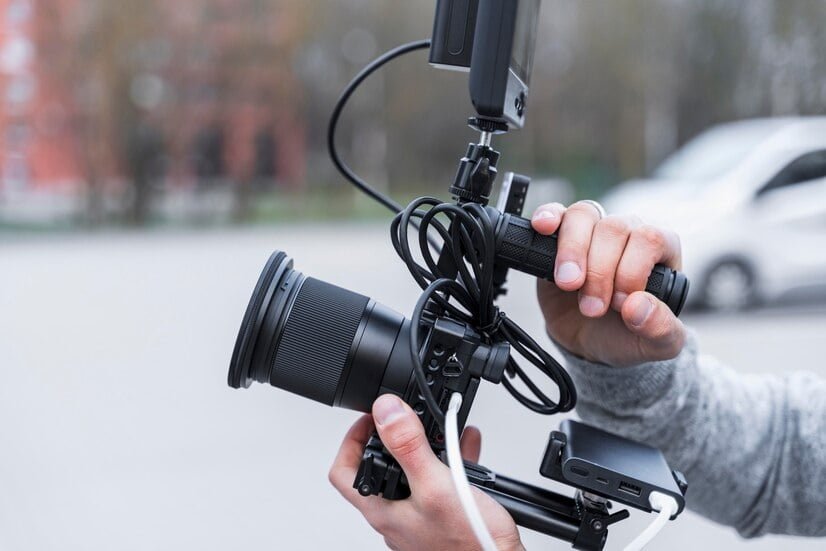“Explore top-quality gimbals in Singapore 🇸🇬 for smooth, professional video recording 📹. Perfect for capturing every moment perfectly! 🎉”
Gimbals are sophisticated mechanical devices designed to stabilize cameras or instruments, allowing them to pivot freely around multiple axes. These devices are pivotal for achieving smooth motion by counteracting unwanted rotations and vibrations, ensuring that your footage remains steady even during movement. Whether you’re shooting a fast-paced action sequence or a serene landscape, a gimbal helps you maintain professional-quality visuals by eliminating the common issues of shakes and jitters that can ruin an otherwise perfect shot.
The Importance of Using a Gimbal for Smooth Video Recording
In the world of video production, the quality of your footage can make or break your project. A gimbal Singapore is an essential tool for anyone serious about capturing high-quality videos, whether you’re a budding content creator or a seasoned professional. By stabilizing your camera, a gimbal ensures that every frame is smooth, enhancing the overall production quality. This results in professional-looking visuals that elevate the storytelling aspect of your video, making it more engaging and enjoyable for your audience. With a gimbal, you can effortlessly achieve cinematic shots that would otherwise require complex setups or advanced camera techniques.
Understanding the Gimbal Market in Singapore
Singapore’s gimbal market is flourishing, reflecting the growing demand for high-quality stabilizing equipment among photographers, videographers, and content creators. As more people turn to video as a medium for communication and expression, the need for reliable tools like gimbals has surged. This demand is driven by the rise of social media platforms, where visually appealing content is key to capturing and retaining audience attention. Additionally, the growing trend of vlogging, live streaming, and video-based marketing has further fueled the need for stabilizing equipment.
In response to this demand, the market has seen significant innovation, with both local and international brands introducing advanced gimbals that offer enhanced features such as automated tracking, time-lapse capabilities, and multi-axis stabilization. These innovations are not only attracting hobbyists and enthusiasts but also professionals who require robust and versatile equipment for their projects. However, with the wide range of options available, choosing the right gimbal can be overwhelming, especially for those new to video production.
Different Types of Gimbals
Gimbals come in various types, each offering different levels of functionality and performance. Some gimbals provide extensive stabilization and versatility, suitable for a wide range of applications, from handheld filming to drone-mounted cameras. These high-end gimbals are equipped with advanced features like 360-degree rotation, multiple shooting modes, and customizable settings, allowing users to achieve complex camera movements and shots with ease.
On the other hand, there are gimbals designed for specific use cases, such as smartphone filming or lightweight mirrorless cameras. While these gimbals may offer less range or durability compared to their professional counterparts, they are often more compact and affordable, making them ideal for casual users or those on a budget. However, the trade-off in range or durability can impact the user experience, especially in challenging shooting environments.
Choosing the Right Gimbal for Smooth Video Recording
When selecting a gimbal, it’s important to consider several factors to ensure you choose the one that best suits your needs. One of the primary considerations is compatibility. Understanding compatibility issues involves recognizing how different cameras, lenses, and accessories interact with the gimbal. Not all gimbals are compatible with every camera system, so it’s crucial to verify that the gimbal you choose supports your equipment. This can prevent issues such as improper balance or limited functionality, which can hinder your ability to capture smooth footage.
Another key factor is the importance of testing the gimbal before purchase. Testing allows you to evaluate the gimbal’s performance, ensuring it meets your expectations in terms of stabilization, ease of use, and overall build quality. It also helps you avoid buyer’s remorse, as you can make a more informed decision and invest in a product that you’re confident will serve your needs.
Tips for Using Gimbals for Smooth Video Recording
To maximize the effectiveness of your gimbal, it’s essential to follow best practices for setup and use. Properly balancing your camera on the gimbal is the first step, as an unbalanced setup can strain the motors and lead to poor stabilization. Adjust the gimbal’s settings according to your shooting environment and ensure that your camera is securely mounted. Practice smooth operating techniques, such as gentle movements and slow panning, to achieve fluid and professional-looking shots.
In addition to setup, employing useful shooting techniques can greatly enhance the quality of your footage. Techniques such as maintaining a steady stance, using controlled movements, and understanding the limitations of your gimbal can help you capture more accurate and precise shots. Whether you’re shooting handheld or using a tripod, these practices are essential for achieving the best results.
Finally, maintaining your gimbal is crucial for ensuring its longevity and optimal performance. Regularly clean the gimbal to remove dust and debris, check for firmware updates that may improve functionality or add new features, and keep the batteries charged to avoid interruptions during shoots. Proper storage is also important, as exposure to extreme temperatures or humidity can damage the gimbal’s sensitive components.
FAQs
Is the gimbal worth it?
Investing in a gimbal can significantly enhance your video stability and quality. For serious videographers or content creators, its benefits often outweigh the initial cost and learning curve.
How much does a gimbal cost?
The price of a gimbal varies greatly, typically ranging from around $100 to over $1,000, depending on features, build quality, and brand reputation.
Do professionals use gimbals?
Yes, professionals frequently use gimbals. These stabilization tools help achieve smooth video footage and capture dynamic shots, enhancing the quality of their work in various creative projects.
